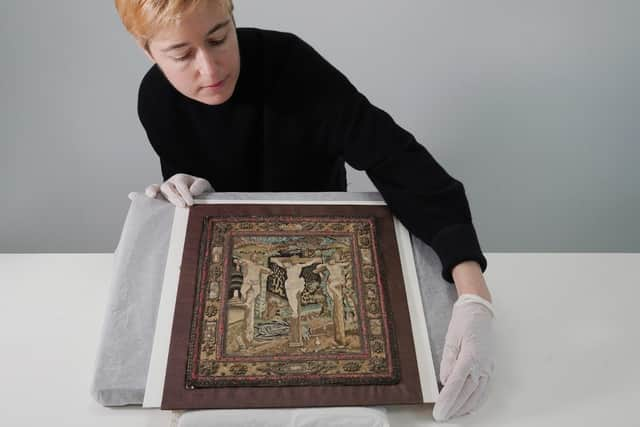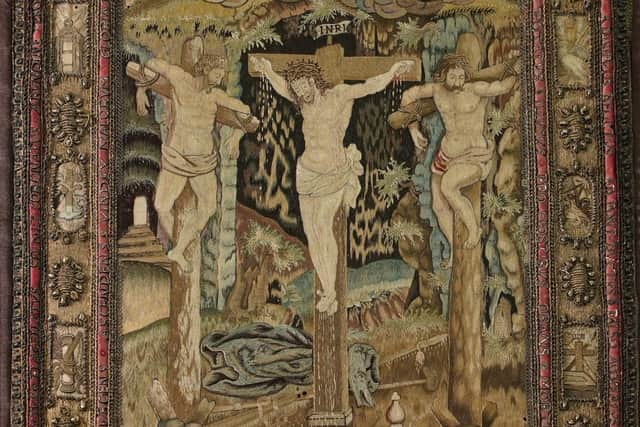Rare and 'dangerous' piece of 17th Century Catholic embroidery enters national collection
The embroidery, which was likely a private altar piece, survived the Reformation and dates to a time when Catholic worship was outlawed and punishable by prison – or worse.
It belonged to Elizabeth Stuart, a member of the Scottish nobility who married into the Howard family, who took the Duke of Norfolk title, the leading Catholic family of the day, in the early 1600s .
Advertisement
Hide AdAdvertisement
Hide AdNow the embroidery, which would have been used in private prayers by Elizabeth Stuart, has been acquired by National Museums Scotland.
Helen Wyld, Senior Curator of Historic Textiles at National Museums Scotland (NMS), said: “Very few of these private devotional pieces survive.They were considered dangerous and many were destroyed.
"Sometimes people did manage to hide them away and use them in secret chapels.
"This piece is so small that it makes sense that it was a portable altar piece.


“It is very unusual for textiles of this kind and quality to survive in the UK, and even more so with such a compelling provenance”
The embroidery, which measures 30cm by 27 cm, is made from coloured silks and gold and silver threads. It depicts Christ on the cross, with blood pouring from his wounds and the tools of his torture.
The depiction is surrounded by a prayer in Latin which sets out the last days of his life.
“The object has been designed to illicit empathy for Christ and is it designed to facilitate prayer,” Ms Wyld said.


Advertisement
Hide AdAdvertisement
Hide AdThe condition of the piece suggests it was treasured by successive generations, she added.
"It’s in very good condition. It is a little bit dirty but that suggests it wasn’t hanging on a wall. It has been well looked and treasured for 400 years by the people who looked after it,” the curator said.
An earlier Stuart family claim that the piece was made by Mary Queen of Scots was later discounted.
Elizabeth Stuart (c. 1610-1673) was daughter of a prominent Scottish nobleman, Esme Stuart, 3rd Duke of Lennox, the first cousin of Henry, Lord Darnley and a favourite of King James VI.
Her father was briefly imprisoned after Charles I disapproved of his daughter’s marriage to the Earl of Arundel, but the couple did eventually wed and had 12 children together.
During the Civil War, the couple fled to Italy and with their lands later confiscated by Oliver Cromwell.
The embroidery has remained in the collection of the Howards, Earls of Arundel and Dukes of Norfolk, since the 17th century.
The acquisition was made with the support of textile collector and philanthropist Leslie B. Durst and coincides with the announcement of three Leslie B. Durst Textile Conservation Internships at NMS.
Advertisement
Hide AdAdvertisement
Hide AdLynn McClean, Principal Conservator at NMS said: “These internships will help safeguard Scotland’s irreplaceable textile heritage and the highly skilled profession of textile conservation. The support of Leslie B. Durst and the Clothworkers Company have allowed us to offer these career-defining opportunities and we are delighted to welcome three new conservators to our team.”
Comments
Want to join the conversation? Please or to comment on this article.
